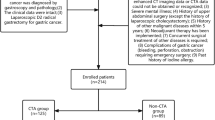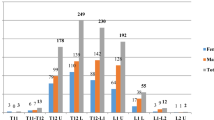Abstract
Objective
The objective of this study is to acquire CT images of the celiac artery by 64-multi-slice spiral CT angiography (64-MSCTA) in gastric cancer patients to facilitate gastric cancer surgery.
Methods
Preoperative 64-MSCTA was performed to observe the origin, course and anatomical variations of the celiac artery and vascular calcifications in 102 gastric cancer patients.
Results
(1) The celiac trunk mostly arose at the level between the 12th thoracic vertebra and the 1st lumbar vertebra; the mean inferior angle with the abdominal aorta was 63.5° (14°–159°), the mean length was 36.29 mm (5.80–73.58 mm), and its course showed many styles. (2) Of 102 gastric cancer patients, 34 patients (33.33 %) were observed with celiac artery variations of whom there were 27 patients with anatomical variations of the hepatic artery, 3 patients with anatomical variation of the left gastric artery and 1 patient with anatomical variation of the splenic artery; in 1 patient, the celiac trunk and the superior mesenteric artery originated from a common trunk. In other cases, it was observed with another variation. (3) The abdominal aortic calcified plaque was observed in 48 patients (47.1 %), and among them, 34 patients were more than 60 years old, and the existence of the abdominal aortic calcified plaque was related to age, significantly (P < 0.01).
Conclusions
The 64-MSCTA largely improves our understanding of the origin, course and anatomical variations of the celiac artery and vascular calcifications in individual patient with gastric cancer. It is recommended that the 64-MSCTA of the celiac artery should be classified as a routine preoperative procedure in gastric cancer patients.



Similar content being viewed by others
References
The Japanese Gastric Cancer Association (2001) Japanese general rules for the gastric cancer study, 13th edn. Kanehara, Tokyo, pp 10–14
Li XH, Sun CH, Feng ST et al (2012) Assessment of 64-slice spiral computed tomography angiography with image fusion for perigastric arteries anatomy. Zhonghua Wei Chang Wai Ke Za Zhi 15(6):594–598
Hiatt JR, Gabbay J, Busuttil RW et al (1994) Surgical anatomy of the hepatic arteries in 1000 cases. Ann Surg 220(1):50–52
Flohr TG, Sehaller S, Stierstorfer K et al (2005) Multi-detector row CT systems and image-reconstruction techniques [J]. Radiology 235(3):756–773
Hu JK, Chen ZX, Zhang B et al (2007) Significance and surgical skill for lymphadenectomy around common hepatic artery in gastric cancer. Chin J Bases Clin Gen Surg 14(5):560–563
Gao YS, Wang CQ, Yun-fei Z (2010) Preoperative evaluation of left gastric artery by 64-slices piral CT angiography in gastric cancer patients. Chin J Gen Surg 25(12):977–979
Ugurel MS, Battal B, Bozlar U et al (2010) Anatomical variations of hepatic arterial system, coeliac trunk and renal arteries: an analysis with multidetector CT angiography. Br J Radio 83(992):661–667
Natsume T, Shuto K, Yanagawa N et al (2011) The classification of anatomic variations in the perigastric vessels by dual-phase CT to reduce intraoperative bleeding during laparoscopic gastrectomy. Surg Endosc 25(5):1420–1424
Shinohara T, Ohyama S, Muto T et al (2007) The significance of the aberrant left hepatic artery arising from the left gastric artery at curative gastrectomy for gastric cancer. Eur J Surg Oncol 33(8):967–971
Forsdahl SH, Singh K, Solberg S et al (2009) Risk factors for abdominal aortic aneurysms: a 7-year prospective study: the Tromsø Study, 1994–2001. Circulation 119(16):2202–2208
Keeling WB, Hackmann AE, Colter ME et al (2007) MF-tricyclic inhibits growth of experimental abdominal aortic aneurysms [J]. J Surg Res 141(2):192–195
Lindholt JS (2008) Aneurysmal wall calcification predicts natural history of small abdominal aortic aneurysms. Atherosclerosis 197(2):673–678
Tujimura T, Nakamura K, Oyama K, et a1 (2009) Selective para-aortic lymph node dissection for gastric cancer. 8th IGCC, Abstract S3, Krakow: 15
Conflict of interest
None.
Author information
Authors and Affiliations
Corresponding authors
Rights and permissions
About this article
Cite this article
Mu, G.C., Huang, Y., Liu, Z.M. et al. Clinical research in individual information of celiac artery CT imaging and gastric cancer surgery. Clin Transl Oncol 15, 774–779 (2013). https://doi.org/10.1007/s12094-013-1002-8
Received:
Accepted:
Published:
Issue Date:
DOI: https://doi.org/10.1007/s12094-013-1002-8




